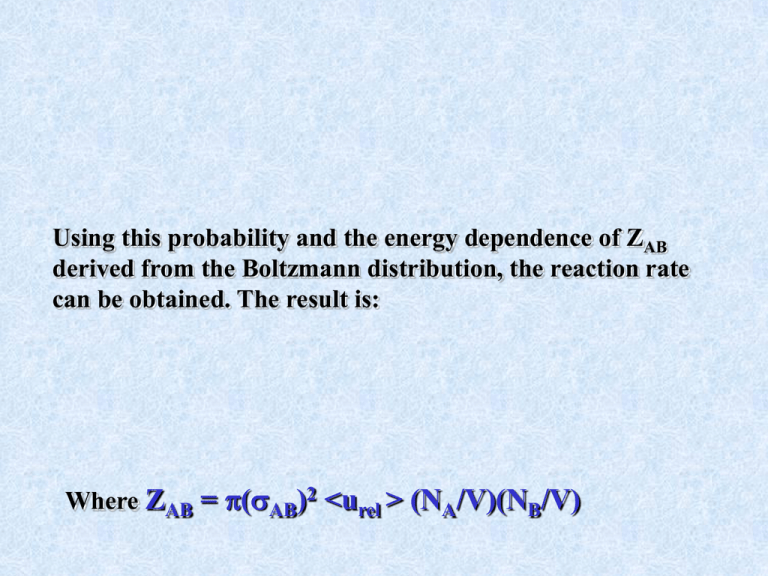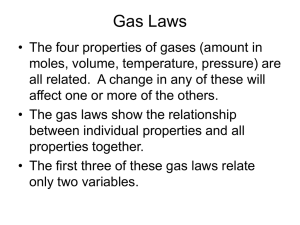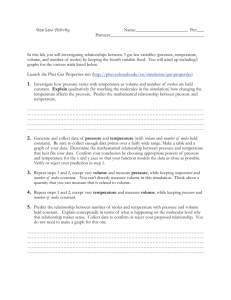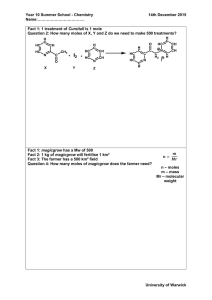Using this probability and the energy dependence of Z
advertisement

Using this probability and the energy dependence of ZAB
derived from the Boltzmann distribution, the reaction rate
can be obtained. The result is:
Where ZAB = (AB)2 <urel > (NA/V)(NB/V)
R= {(
2 <u > e -EA/RT} (N /V)(N /V)
)
AB
rel
A
B
Often kR is written kR=A e -EA/RT
Since <urel>=(8kT/)1/2, A increases linearly with
square root of T.
Temperature Dependence of kR
There are two places where T comes into the expression
for kR
Orientation Effects: The Steric Factor
We have left out one consideration in our model for R,
the reaction rate.
For example, in the reaction of NO+O2 to form NO2, the one O
from O2 must attach to the N in NO, not the O in NO!
Might expect collisions between NO and O2 that occur at the
nitrogen end of NO will be more effective in producing NO2
than collisions at the O end of NO!
O
N
Cl
ClNO + ClNO
+
O
N
Cl
No reaction
Cl
Cl2 + 2 NO
Cl
+
O
N
Cl
+
Cl
N
O
N
O
+
Steric Effects on Chemical Reactions
N
O
Bonus * Bonus * Bonus * Bonus * Bonus * Bonus
Units (cgs) and typical numbers:
Chemical Kinetics: Laboratory Measurements
We now have a model for chemical reactions (Binary
Collision Model) and need to deal with practical issue
of how to make observations in the laboratory.
This will involve both analyzing chemical reaction data
from laboratory measurements and extending our models.
A) Consider the reaction
2A B + C
Rate time rate of change of concentration of any of the
substances involved - reactants or products.
Usual convention: R = -
1 dCA dCB dCC
2 dt
dt
dt
Could measure the rate by measuring the composition
of the reaction vessel as a function of time. Example:
t=0
NAº = moles A
NBº = NCº = 0
t = t1
NA’ = moles A NB’ = NC’ = moles B, C
Consider the reaction
2A B + C
Consider the reaction
2A B + C
Two moles of A gives one mole of B. Or moles of B formed
must equal half the number of moles of A reacted.
t=0
NAº = moles A
NBº = NCº = 0
t = t1
NA’ = moles A NB’ = NC’ = moles B, C
Take deerivative of both sides with respect to t
Consider the reaction
2A B + C
NAo/V= CAo
The slope of such a plot is directly
related to the reaction rate.
CA
t
In general the rate for such a reaction turns out to be a function
of the concentrations of all of the substances involved
f could have any form. In many cases f has the form
k is a constant called the rate constant. is the order of the
reaction for the component A
= 1 1st order in A
= 3 3rd order in A
Overall order of a reaction =
+ + . The order has absolutely nothing to do with the
stoichiometry of the reaction,
The point is that one knows nothing about , , from
looking at the chemical equation for the reaction.



